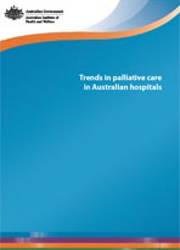Summary
Trends in palliative care in Australian hospitals provides a comprehensive picture of the nature and extent of palliative care separations in Australian public and private hospitals. In this report, a ‘palliative care separation’ is defined as an episode of admitted patient care for which the principal clinical intent of the care was palliation during part or all of that separation. Such care may have been delivered in a hospice, a dedicated palliative care ward or in other admitted patient beds in a hospital.
Over 50,000 palliative care separations in 2008–09
In 2008–09, there were 52,347 palliative care separations in Australian hospitals. Patients aged 75 years and over accounted for almost half (49%) of these separations, while those aged under 55 years accounted for 12%.
Palliative care separations accounted for a total of 653,468 patient days in 2008–09, with an average length of stay of 12.5 days per separation. This is almost four times longer than the average length of stay of 3.2 days for all hospital separations.
Clear differences by state and territory in the age-standardised rate of palliative care separations were noted. As well, separation rates for palliative care were higher than average for males, Indigenous Australians and people living in areas of lower socioeconomic status.
Cancer patients comprised the majority of those using palliative care services in admitted patient settings—a principal diagnosis of cancer was recorded for 60% of the palliative care separations. When both principal and additional diagnoses were taken into account, this percentage increased to 77% of the palliative care separations.
Substantial increase in palliative care separations over time
Over the 10-year period from 1999–00 to 2008–09, the number of palliative care separations in admitted patient care increased by 56%. Much of this increase was in public hospitals. Meanwhile, the average length of stay in hospital per palliative care separation remained fairly steady over the period.
Increase in palliative care before death in hospital
Of all deaths in Australia in 2008–09, just over half (52%) occurred in an admitted patient setting within a hospital.
During the period from 1999–00 to 2008–09, there was an increase (from 21% to 34%) in the proportion of people who were palliative care patients during the hospital stay that ended with their death.
In 2008–09, almost 7 out of 10 (69%) patients with cancer as the principal diagnosis were palliative care patients during the hospital stay that ended with their death. This is higher than the proportion observed for a number of other diseases.
Those cancer patients whose usual residence was in a Major city and those living in areas of highest socioeconomic status were relatively more likely than other cancer patients to have been a palliative care patient during the hospital stay that ended with their death. In contrast, there was no marked difference by Indigenous status and, contrary to previous research, older cancer patients were no less likely than their younger counterparts to have been a palliative care patient during their final hospitalisation.



